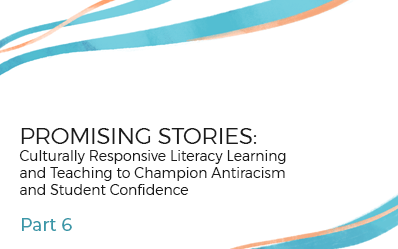Promising Stories, Part 6: It’s All About Relationships
This is the sixth and last part of the essay series by Laura Benson, ISS Director of Curriculum and Professional Development. Read Part 1, Part 2, Part 3, Part 4, and Part 5.
Promising Stories: Culturally Responsive Literacy Learning and Teaching to Champion Antiracism and Student Confidence
In the community, a nurturing attitude is characterized by unselfish caring, supportiveness to share time.
Clifton Taulbert, 8 Habits of the Heart
It’s All About Relationships
Culturally responsive schools foster relationships among all community members. Culturally responsive teachers orchestrate learning to empower students individually and collectively. Students in these schools do not seek self-centered gain while ignoring public welfare. As Eric Jensen in Teaching with the Brain in Mind and Pat Wolf in Brain Matters profile the brain’s need for collaboration to learn and outline the benefits of social relationships to support students’ learning, motivation, and engagement.
Ladson-Billings (1994) studied actual instruction in elementary classrooms and observed these values being demonstrated. She saw that when students were part of a more collective effort designed to encourage academic and cultural excellence, expectations were clearly expressed, skills taught, and interpersonal relations were exhibited.
Students behaved like members of an extended family-assisting, supporting, and encouraging each other. Students were held accountable as part of a larger group, and it was everyone’s task to make certain that each individual member of the group was successful. By promoting this academic community of learners, teachers responded to the students’ need for a sense of belonging, honored their human dignity, and promoted their individual self-concepts (Gay, 2000).
Human relationships always help us to carry on, because they always presuppose further developments, a future.
Albert Camus
MacArthur Award–winning author Lisa Delpit (2006) advocates that teachers be better “cultural transmitters” in the classroom, where prejudice, stereotypes, and cultural assumptions breed ineffective education. Delpit suggests that many academic problems attributed to children of color are actually the result of miscommunication, as primarily white teachers and “other people’s children” struggle with the imbalance of power and the dynamics plaguing our system.
Alfred Tatum also advocates relationships as the cornerstone of effective, culturally sensitive teaching. To help students succeed, he suggests: foster human kinship; remove student stressors; model warmth, acceptance and consistency; nurture positive transference; push out less and pull in more; and get with students as opposed to getting on students. Good teaching is “not just about students’ literacies; it’s about their lives.”
Relationships are why I was first attracted to conferences, small group partnerships and guided reading, and book clubs. These learning exchanges and settings give me daily opportunities to connect with students and know them more deeply. Peer partnerships, too, are vital learning activities. Creating collaborations for and with students, again, I consider how students learn outside of school and utilize these culturally relevant relationship models in shaping students’ learning rituals.
Thoughtfulness and attention to students’ cultures leads to developing stronger, more connected, and respectful relationships among students, teachers, parents, and community members. One lens for understanding your school’s growth and progress in creating culturally responsive learning is evaluating students’ relationships with one another. Here are a few questions I ask when studying this issue with colleagues:
STUDENT RELATIONSHIPS
One way I monitor and evaluate issues of culture and race within school communities is to look toward the students for courageous action (Singleton, 2005) and harmonious interaction. Do students…
…create and sustain multi-ethnic, multi-racial friendship?
…eat lunch with one another?
…play on the playground/hang out with one another during recess?
…sit with peers of different races and/or gender in class (when seat assignments are students’ choice)?
…have sleepovers with one another?
…invite friends of different races than their own over for home visits/play dates?
…date peers of races different than their own?
People don’t change their behavior when other people yell at them, shame them, or send them away to be alone. People change their behavior when they feel heard, understood, and love. Growth and change require connection and compassion.
Kate Hurley
All installments of the Promising Stories series can be found here:
- Part 1: Introduction
- Part 2: It Starts With Stories…Your Stories, My Stories, Our Stories
- Part 3: Culture Connections, and Build on Students’ Strengths
- Part 4: Reflection, and Outside Learning as an Avenue for Inside Learning
- Part 5: Books are Mirrors and Windows
- Part 6: It’s All About Relationships
View References and Resources for Developing Culturally Responsive Learning and Nurturing Antiracism
You can also follow Laura at @lbopenbook, plus view her curated antiracism padlet here.

